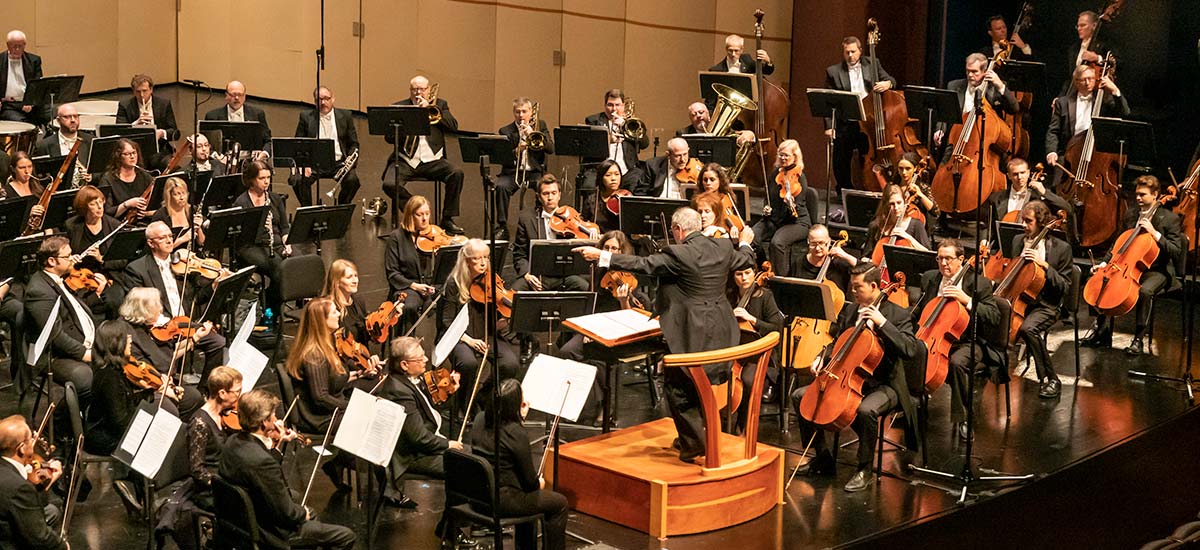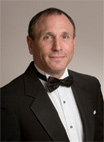
Dayton Philharmonic Orchestra
Dayton Philharmonic Orchestra has a distinguished place in the Gem City’s history as one of the Miami Valley’s oldest and longest standing cultural institutions. As of July 1, 2012, the DPO is part of the Dayton Performing Arts Alliance. A regional orchestra with 83 contracted musician and rich in artistic tradition, the Philharmonic is proud to call the Benjamin and Marian Schuster Performing Arts Center its home.
 The Schuster Center is a world-class, state-of-the-art performance hall that attracts arts aficionados from all corners of Ohio and around the nation. In addition, the Philharmonic also performs at Westminster Presbyterian Church and the Dayton Masonic Center.
The Schuster Center is a world-class, state-of-the-art performance hall that attracts arts aficionados from all corners of Ohio and around the nation. In addition, the Philharmonic also performs at Westminster Presbyterian Church and the Dayton Masonic Center.

Music Director Neal Gittleman inspires each listener’s imagination with his unique programming, in-depth comments, his easy-going style and infectious enthusiasm for music. His focus is to make symphonic music readily available, as well as appreciated, by all musical tastes.
Under his direction, the Orchestra has received the American Society of Composers, Authors and Publishers (ASCAP) award for Adventurous Programming of Contemporary Music nine times. Maestro Gittleman continues to bring breakthrough programming to the Dayton Philharmonic. His tenure has seen the addition of five new subscription series: Classical Connections, a beginner’s guide to better understanding of classical music; the Family Series, three concerts designed so that families can experience the wonders of classical music; Symphony Sundaes featuring the music of the late 1700 and early 1800’s; and, the Rockin’ Orchestra which celebrates the rock ‘n roll that is especially enhanced in a symphonic setting. Under Gittleman, the DPO has also expanded and diversified its non-subscription special event program offerings including the annual New Year’s Eve concert as well as a wide range of innovative Special Events.
Neal Gittleman has been on the Dayton Philharmonic podium since September 1995. He continues to broaden the Orchestra’s repertoire with more 20th century compositions and additional variety in programming. He has introduced a number of world, American and Dayton Philharmonic premieres and has expanded performance collaboration within the Dayton arts community. In 2010, the Orchestra started a new in-house label, DPO Alive. There are now three releases which are sold as online downloads and physical CDs in the concert hall. With Maestro Gittleman at the helm, the Orchestra continues to enjoy renewed community support and increased artistic vision.
Gittleman’s mission naturally carries on the dream of the Orchestra’s founding Music Director, Dr. Paul Katz.
The Dayton Philharmonic Orchestra tradition began in June 1933 when the then-young conductor and violinist, Katz, and his 26 professional area musicians performed Dayton’s very first symphonic concert. They called themselves the Dayton Chamber Orchestra, but from the start, Katz had his musicians performing regular orchestral repertoire he had re-scored for the chamber-size ensemble. At the end of the inaugural four-concert season, Daytonians were so enthusiastic that it was obvious another season must be planned. Community volunteers joined together to incorporate the budding non-profit Dayton Chamber Orchestra Society, in addition to selling subscriptions for the second season. From its earliest beginnings, the Orchestra has belonged to its community. Miami Valley citizens have always expressed deep feelings for it as well as for the musicians. As Dayton came out of the Great Depression in the mid-thirties, ticket sales and membership in the Society climbed dramatically. Even the most cynical skeptics began turning into the most ardent supporters.
In April 1934, the Chamber Orchestra Society changed its name to the Dayton Philharmonic Orchestra. Katz and the musicians were dedicated to bringing symphonic music to their community. So much so that during the winter months musicians would rehearse in their overcoats because there was no heat on stage. A key contributor to the success of the Dayton Philharmonic Orchestra was Miriam Rosenthal, a powerful businesswoman in the community, who worked side by side with Katz to build his dream. Rosenthal became the Orchestra’s Executive Director during its third season. She remained in that post for three decades until her death in 1965. The financial support, guidance and devotion she brought to the organization marked her tenure. Orchestra historians have singled out Katz and Rosenthal as the two most indispensable and important persons in building the Dayton Philharmonic into the community treasure that it is today.
For 42 years, Katz conducted and refined the Orchestra he had created. A professional musician full of vision, he devised a plan whereby students could be bused to the Orchestra to hear live music in a performance hall. Thus, in November 1934, Katz introduced the first Young People’s Concert to Dayton. The success of these concerts continues today, attracting audiences of more than 14,000 school children each year. The early Young People’s Concerts spawned what has evolved into a full-scale, award-winning education program that has been an integral part of the education in the Miami Valley ever since. Each year, the Orchestra and more than 250 area schools work together to introduce music into more than 85,000 children’s lives. The sold-out programs range from in-school ensembles, Young People’s Concerts, pre-school concerts and master classes, to the Dayton Philharmonic’s newest education program: SPARK (School Partners With Artists Reaching Kids). The education programs reach schools and children in a 12-county area.
Realizing how much choral music would enhance the Orchestra’s concert programming, in 1935 Katz founded the original all-volunteer Dayton Philharmonic Chorus. Currently, the 140-plus members, who are residents of the Miami Valley, join the Orchestra in concert several times a season to perform some of the most challenging and beautiful choral music. Weekly rehearsals are mandatory for membership and Chorus members attend them with pride.
In 1937, the Dayton Philharmonic Training Orchestra was formed to give young area musicians an opportunity to study challenging orchestral music and to sharpen their cultural awareness and appreciation of music. Another Katz first, the former Training Orchestra later became the Dayton Philharmonic Youth Orchestra, which today is well into its sixth decade with its primary goals unchanged.
Katz was so enthusiastic about satisfying everyone’s musical taste that in 1945, he introduced the first Pops Concerts to Dayton. The new concept in musical entertainment was quick to catch on in the Gem City. So much so that today there are eight Bank One SuperPops Concerts per season featuring the Dayton Philharmonic Orchestra with unparalleled pop stars. The Pops concerts were in addition to the established classical series concerts that also frequently brought internationally known classical guest artists to town.
Indisputably, Dr. Paul Katz was a visionary and a pioneer. He set in motion a Dayton tradition that is thriving into the 21st century. At the end of the 1974-1975 season, Katz retired as the Orchestra’s founding Music Director. He had been on the podium for 42 years.
Charles Wendelken-Wilson began his 12-year tenure as the Dayton Philharmonic’s second Music Director in the 1975-1976 season. He continued to bring in world-class guest artists and to fine tune the musicians’ artistic talents. Under him, the Orchestra grew dramatically, in both innovative programming and in ticket sales. While Katz may have introduced individual pops concerts to the community, Wendelken-Wilson started a subscription Pops series in 1978-1979. He expanded the Pops series to two nights and added a second night to the nine-concert classical series. He also began the still popular All Orchestra Night Concerts. Wendelken-Wilson’s work with the Dayton Philharmonic Chorus brought about its reorganization as an even more vital part of the Orchestra. His artistic leadership through twelve seasons continued to assure the Dayton Philharmonic’s prominence as it neared its half-century mark.
Isaiah Jackson served as the Orchestra’s third Music Director from 1987 to 1994. Drawing upon his experiences as a guest conductor of some of the world’s major orchestras, he introduced subscribers to such programming highlights as Dayton’s first-ever performance of Mahler’s Symphony No. 8, Symphony of a Thousand, a true tour de force for the more than one-hundred performers on stage.
The Dayton Philharmonic Orchestra Board of Trustees consists of community and business leaders. They meet every two months, September through June, to set policy and establish strategic direction of the Dayton Philharmonic Orchestra Association and the Orchestra. New executive officers are elected every two years. Forty-two Trustees each serve a three-year term, with a maximum of six consecutive years. The Music Director serves as the Orchestra’s artistic director, choosing all programming and selecting guest artists. The administrative staff is composed of directors (development, education, finance, marketing and public relations, and orchestra operations) and support staff. Sixteen staff members, headed by President Paul Helfrich, are responsible for the day to day operations of the Orchestra.
The Dayton Philharmonic is a fully professional, unionized orchestra comprised of musicians who also teach in area high schools, universities and privately. In addition to a full symphony orchestra, the Dayton Philharmonic supports a chamber orchestra, five chamber ensembles, a professional concert band, a 140-voice all-volunteer Chorus and two youth orchestras. The yearly budget of just under $4 million makes the Dayton Philharmonic Orchestra the largest performing arts institution in the Miami Valley.
Over the years, the Orchestra has continued to build upon its outreach programs. In 1998, a historic Concert for Peace joined together the Dayton Philharmonic Orchestra and the Sarajevo Philharmonic in celebration of the fourth anniversary of the signing of the Dayton Peace Accords. The concert symbolized the partnerships of the people of Dayton and Sarajevo in the building of lasting peace in Bosnia. The program had an international flavor, with music by Bosnian, French, German, American and English composers.
Locally the Dayton Philharmonic has joined performance forces with the Boonshoft Museum of Discovery, the Wright State University Collegiate Chorale, Central State University Chorus, Dayton Art Institute, Dayton Bach Society, Dayton Ballet, Dayton Boys’ Choir, Kettering Children’s Choir, The Human Race Theatre Company, Muse Machine and The Puerto Rican Cultural Society, among many others. Dayton’s public radio stations WDPR/WDPG-FM broadcast all of the Orchestra’s classical concerts and interview many of its guest artists, thus making the Dayton Philharmonic’s programs available to a wide range of Miami Valley residents. In addition, many concert rebroadcasts and simulcasts take place between with Classical 88.1 WDPR. Year after year, the Dayton Philharmonic continues to offer its patrons unique, challenging programming that stimulates and inspires the imagination.
